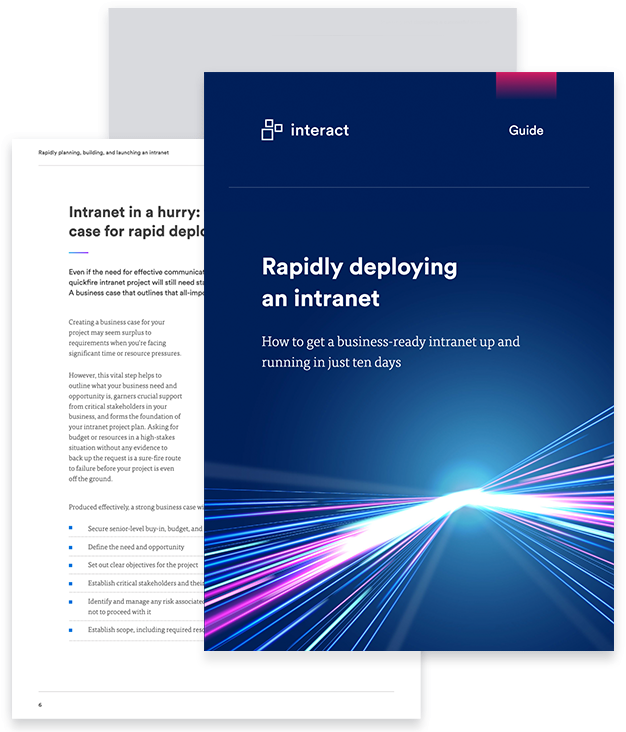As we continue to adjust to a new normal in extraordinary circumstances, many organizations face the need to adapt staffing in response. How can we offboard, support, and then re-engage furloughed staff?
Among the many challenges facing organizations in the face of the coronavirus pandemic, an uncertain economic climate and dramatic shift in demand for products and services have impacted our ability to operate normally.
To maintain financial stability and retain staff, many of us face the need to furlough parts of our workforce: supported in some cases by government programs designed to help both employer and employee financially.
The decision to furlough – where employees are kept on payroll without terminating their employment but are not working for their organization – is ideally done in consultation with the members of staff in question, or their unions. Staff members take a period of absence or vacation, but they may continue to be paid.
Pay level and the length of furlough depends on the employer and external support available. The situation is different in the UK and the US, where external government programs will have an impact on decision-making.
For those companies who may otherwise struggle to pay wages or those staff who aren’t able to perform their roles due to restrictions in place during the coronavirus outbreak, it’s a difficult but fair and necessary decision against the backdrop of a hugely challenging landscape.
However, it will inevitably cause some concerns, potential anxiety, and additional challenges for both organization and individual. Managing the process carefully and sensitively is imperative.
Preparing and managing a remote team during COVID-19
What do our furloughed employees need from us?
While those individuals are not working or earning money for our business, they are still employees. Understanding this simple fact must be the underlying driver for how we manage the process.
While furloughing is widely recognized in some countries, for the UK in particular, it was relatively unknown before the introduction of the government Coronavirus Job Retention Scheme. Staff impacted may not fully understand what the process involves or the implications for their role.
First and foremost, our employees need information: and transparency from their managers and the business. Explaining clearly why the decision has been made and what the process involves can provide much-needed reassurance and clarity.

Safeguarding staff mental wellbeing and supporting them in the face of this significant adjustment is the next crucial – and ongoing – step. Reactions and feelings about furlough will vary; some individuals may welcome the opportunity to help them look after children at home or support vulnerable family members, for others, the process is more difficult.
Without work as a focus, some employees may find the prospect of having nothing to do or becoming isolated overwhelming.
If they are one of only a selection of employees, they may inevitably ask ‘why me?’ or fear they aren’t valued by the organization if others remain working. If colleagues are busy, they may feel guilty about not being able to help.
Some may worry about the financial implications or if they’ll face permanent redundancy if the situation continues. Without work as a focus, others may find the prospect of having nothing to do or becoming isolated overwhelming. These are all significant and serious concerns for us as employers and managers.
When staff return to work, they face a further adjustment period. They may feel ‘out of the loop’ and face a further change to their daily routine. Getting back up to productivity may take time and require practical support and understanding from the business and their manager.
Our furloughed staff, then, need reassurance and clear communication, support in managing their feelings or response to the change, to retain a sense of connection to their role and organization, and a considered ‘re-boarding’ process on their return.
How can we manage this complex process from afar?
Offboarding furloughed staff
Once your organization makes the decision to roll out a program of furlough, managers will need to speak directly with employees to communicate why this is being proposed and gain their consent.

This needs to be an open conversation, undertaken (virtually) face-to-face via video call where possible. Managers should be prepared to answer questions and hear the concerns of employees with understanding.
As part of the offboarding process, organizations should look to:
- Make boundaries and expectations clear: affected employees should not work in any way during the furlough period, so it’s essential to make this clear to staff. They can, however, continue to train or take on professional development; if this is something your organization offers, this may be an ideal time to discuss it.
- Signpost staff to support: if you have an Employee Assistance Program (EAP), it may be beneficial to direct staff for support if they have concerns about finances or mental wellbeing, for example.
- Consider a dedicated content area for furloughed employees: staff may have questions, require further clarification, or want to refer back to additional information once the initial news has sunk in. A dedicated area on your intranet managed by permissions for those affected can provide the reassurance of a go-to area for everything they need.
- Ensure outstanding responsibilities are reassigned and handed over: if parts of individual employees’ roles will continue to be required during the furlough period, ensure a handover for vital duties and processes.
- Consider temporary de-provision or amended access for tools and applications: your furloughed employees are temporarily not working, so, unlike a member of staff leaving the business, there’s no need to terminate all their corporate accounts or revoke access. However, in the interests of supporting their boundaries while off work and ensuring business data is secure, you may want to evaluate what information and tools they can, and should, retain access to.
- Communicate clearly to the rest of their team and the organization: it’s not only the furloughed staff affected by the change; it has repercussions and will inevitably raise concerns for those around them also. Ensure staff across your organization are informed of the who and why, and offered the opportunity to ask questions or discuss further if they need reassurance.
At all stages of what is undeniably a difficult process, we mustn’t forget the value people place on their roles: for many, it’s more than just a means to pay the bills.
Being unable to work can leave many of us questioning our purpose, value, or self-worth, with implications on confidence and wellbeing. Understanding and empathy in all communication is important, and it needs approaching on an individual basis.

Ensure when communicating that you’re reiterating the value and worth that individual brings to their role and the organization; highlight their past achievements, and where possible, discuss those projects they’ll be taking on when they return.
The majority of these responsibilities lie with line managers, who should play the central role in managing the process. However, given the nature of current circumstances and the potential uncertainty it will evoke, both HR and senior leadership should be playing a strong supporting role throughout.
At this stage, there is no such thing as over-communication: transparency and clarity are vital.
Preparing and managing a remote team during COVID-19
Keeping furloughed staff connected
While they aren’t undertaking work, there are many ways your staff can stay connected to your organization and their peers.
Staying in touch and retaining this sense of belonging will not only support their individual wellbeing but also ease their return to work by keeping them up to date with developments and maintaining professional links with their teams and colleagues.

All engagement with your organization needs to be voluntary on behalf of the employee. After all, they’re not currently working for the organization and can’t be required to attend meetings or catch-ups, even if the end goal is to support them. Distributing communication that staff will want to engage with vital. Internal communications, therefore, has a vital role to play in maintaining these links from a distance.
Ideas for staying in touch include:
- Scheduling visual catchups with line managers on a regular basis: make these optional but commit to a regular time and show up for your staff, even if it’s just a quick five-minute check-in.
- Create a dedicated community area on your intranet for furloughed staff. Provide all crucial need-to-know HR, legal, and support documentation in one place for reassurance. By complementing this with more informal communication such as blogs, forums, or social tools, you can also provide furloughed staff with a space to share experiences, tips, or ideas whilst not working.
- Ensure they can access company news and updates: your company culture is the glue that holds your organization together, particularly during challenging times. It’s made up of many elements, from your senior leaders to your company values, social factors, and your staff themselves. Don’t cut off access for furloughed employees. If you have company-wide news, virtual town halls, recognition communications, or in-house informal updates, ensure staff can access these crucial pieces of their organization from a distance. Maintain intranet accounts or manage with permissions to ensure they can access the important bits.
- Think about how they’re checking information: during a period of furlough, staff are unlikely to be using their work devices; it’s far more convenient to quickly check-in using their mobile devices. Ensure you’re creating communications that are accessible and digestible: video, pictures, or other rich content, microblogging updates, recordings of town halls, podcasts, and more.

- Tailor your communication: make sure you’re giving staff content that’s relevant, and you’re not alienating those who currently aren’t working. Use personas or create a dedicated audience group and only push out those updates that are relevant. If you have an internal communications newsletter, pull through only those pieces of interest, and avoid work-related information.
- Include some social check-ins: the creative approaches to staying connected have already extended to the digital workplace, whether that’s team quizzes, virtual after-work drinks, or informal challenges, idea sharing, and competitions. Make sure those options are open and communicated to your furloughed staff; include upcoming events on a dedicated calendar, or send push notification and email invites so they have an opportunity to opt-in to the more fun parts of your organization from afar.
- Keep access open to internal social channels: if you operate social enterprise networks, channels, or teams for non-work conversation or communities, remind staff that these remain open to them if they’re missing watercooler chat or want to catch up with colleagues.
- Encourage them to follow company social media channels, particularly if you have channels that are dedicated to employer branding or communicating your culture that are being updated at this time. This will instill a greater sense of connection to their organization.
- Encourage non-furloughed staff to connect or check-in with their peers. Those on furlough may embrace the opportunity to take a break from their work, so, despite best efforts on behalf of the organization, they may simply be unreceptive or uninterested in outreach efforts. However, we are social creatives by nature. If staff already have colleagues they have a good connection with, they may be more open to keeping in touch on an informal basis.

Ensure communications with all staff are supplemented with signposting for additional resources and support; whether that’s from your Employee Assistance Program (EAP) or third-party organizations such as Mind or Mental Health.
The overall ethos with supporting employees on furlough is to show openness and inclusion, creating those spaces and opportunities to help them to stay connected and get the necessary information and support they need. The more opportunities available, the more likely it is there will be something for each employee personality type. However, it’s also something that ultimately lies in the hands of the staff member.
These efforts not only help those who aren’t working but those remaining in work also. Furloughing may lead to a decline in staff morale or feelings of anxiety; showing all staff you take your commitment to them seriously and striving to maintain engagement can help maintain morale.
Preparing and managing a remote team during COVID-19
Guide
Preparing and managing a remote team during COVID-19
As organizations worldwide adjust to mass remote working in response to the coronavirus pandemic, this handy guide and free checklist ensures your staff are equipped and supported for a new way of working. Download the free guide
Welcome back: after furlough
While many countries still face uncertainty over when circumstances will change and staff may be able to return to work, preparation for the event should still be on the radar.

It’s a process that will inevitably take time and need sensitivity in approach and execution.
The more notice organizations can give, the better; in some cases, a staggered approach to return to work may benefit both employer and employee.
Communication is key at every stage. The more we’re talking with and listening to our employees, the better placed we are to adapt and support them.
This includes phasing need-to-know business updates and information, and bringing staff back into team meetings or briefings before they’re expected to ‘jump back in.’ Providing status updates on work completed and ongoing across teams may be needed to re-orientate staff; they will need to build an understanding of wider business changes also.
Managers need to be flexible and understand that it may take time to get back up to productivity.
It’s a transition period; opening the doors to all employees in the organization to return to work won’t see an immediate return to ‘business as usual’, particularly for those industries impacted by the broader economic repercussions presented by the pandemic. There will be inevitable changes in work volume, processes, and responsibilities.

Peer connections can take time to re-establish, particularly when staff have been communicating exclusively through digital channels at a distance. If you’ve had staff changes during the furlough period, this can add to a sense of disconnect or being out of the loop. Introducing some social elements to the re-boarding process can help to build on these and connect staff to your culture and each other.
It’s important that all these changes and an understanding of the experience for furloughed staff are taken seriously. Communication is key at every stage. The more we’re talking with and listening to our employees, the better placed we are to adapt and support them.
While this may be a situation many of us have never confronted before, if staff feel valued, included, supported, and informed, they’ll be better placed to return with renewed motivation and focus. How we hold onto that connection with our furloughed staff can make a huge difference.
Preparing and managing a remote team during COVID-19



